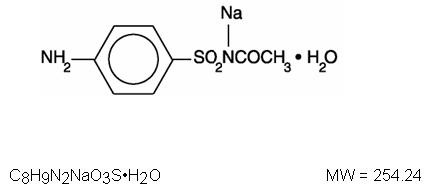Sulf 10
Sulf 10
FULL PRESCRIBING INFORMATION
Sulf-10®
(SULFACETAMIDE SODIUM
Ophthalmic Solution, USP) 10%
Sulfacetamide sodium ophthalmic solution, USP, is a sterile, topical anti-bacterial agent for ophthalmic use. The active ingredient is represented by the following structural formula:

Chemical name: N-Sulfanilylacetamide monosodium salt monohydrate.
THE PLASTIC SQUEEZE BOTTLE CONTAINS:
Active: Sulfacetamide Sodium 10% (100 mg/mL).
Preservative: Thimerosal 0.1 mg/mL
Inactives: Boric acid, hydroxypropyl methylcellulose 2208 (4000 cps) 1.0 mg/mL, sodium thiosulfate and purified water. Sodium carbonate anhydrous and/or hydrochloric acid to adjust pH (7.0-7.4) when necessary.
THE DROPPERETTES® APPLICATOR CONTAINS:
Active: Sulfacetamide Sodium 10% (100 mg/mL).
Preservative: Thimerosal 0.05 mg/mL
Inactives: Boric acid, sodium thiosulfate and purified water. Sodium carbonate anhydrous and/or hydrochloric acid to adjust pH (7.0-7.4) when necessary.
Microbiology
The sulfonamides are bacteriostatic agents and the spectrum of activity is similar for all. Sulfonamides inhibit bacterial synthesis of dihydrofolic acid by preventing the condensation of the pteridine with aminobenzoic acid through competitive inhibition of the enzyme dihydropteroate synthetase. Resistant strains have altered dihydropteroate synthetase with reduced affinity for sulfonamides or produce increased quantities of aminobenzoic acid.
Topically applied sulfonamides are considered active against susceptible strains of the following common bacterial eye pathogens: Escherichia coli, Staphylococcus aureus, Streptococcus pneumoniae, Streptococcus (viridans group), Haemophilus influenzae, Klebsiella species, and Enterobacter species.
Topically applied sulfonamides do not provide adequate coverage against Neisseria species, Serratia marcescens and Pseudomonas aeruginosa. A significant percentage of staphylococcal isolates are completely resistant to sulfa drugs.
For the treatment of conjunctivitis and other superficial ocular infections due to susceptible microorganisms and as an adjunctive in systemic sulfonamide therapy of trachoma:
Escherichia coli, Staphylococcus aureus, Streptococcus pneumoniae, Streptococcus (viridans group), Haemophilus influenzae, Klebsiella species, and Enterobacter species.
Topically applied sulfonamides do not provide adequate coverage against Neisseria species, Serratia marcescens and Pseudomonas aeruginosa. A significant percentage of staphylococcal isolates are completely resistant to sulfa drugs.
Hypersensitivity to sulfonamides or to any ingredient of the preparation.
FOR TOPICAL EYE USE ONLY – NOT FOR INJECTION. FATALITIES HAVE OCCURRED, ALTHOUGH RARELY, DUE TO SEVERE REACTIONS TO SULFONAMIDES INCLUDING STEVENS-JOHNSON SYNDROME, TOXIC EPIDERMAL NECROLYSIS, FULMINANT HEPATIC NECROSIS, AGRANULOCYTOSIS, APLASTIC ANEMIA AND OTHER BLOOD DYSCRASIAS. Sensitizations may recur when a sulfonamide is readministered, irrespective of the route of administration. Sensitivity reactions have been reported in individuals with no prior history of sulfonamide hypersensitivity. At the first sign of hypersensitivity, skin rash or other serious reaction, discontinue use of this preparation.
Prolonged use of topical anti-bacterial agents may give rise to overgrowth of nonsusceptible organisms including fungi. Bacterial resistance to sulfonamides may also develop.
The effectiveness of sulfonamides may be reduced by the para-aminobenzoic acid present in purulent exudates.
Sensitization may recur when a sulfonamide is readministered irrespective of the route of administration, and cross-sensitivity between different sulfonamides may occur.
At the first sign of hypersensitivity, increase in purulent discharge, or aggravation of inflammation or pain, the patient should discontinue use of the medication and consult a physician (see WARNINGS).
To avoid contamination, do not touch tip of container to eye, eyelid or any surface.
Sulfacetamide preparations are incompatible with silver preparations.
No studies have been conducted in animals or in humans to evaluate the possibility of these effects with ocularly administered sulfacetamide. Rats appear to be especially susceptible to the goitrogenic effects of sulfonamides, and long-term oral administration of sulfonamides has resulted in thyroid malignancies in these animals.
Animal reproduction studies have not been conducted with sulfonamide ophthalmic preparations. Kernicterus may occur in the newborn as a result of treatment of a pregnant woman at term with orally administered sulfonamides. There are no adequate and well controlled studies of sulfonamide ophthalmic preparations in pregnant women and it is not known whether topically applied sulfonamides can cause fetal harm when administered to a pregnant woman. This product should be used in pregnancy only if the potential benefit justifies the potential risk to the fetus.
Systemically administered sulfonamides are capable of producing kernicterus in infants of lactating women. Because of the potential for the development of kernicterus in neonates, a decision should be made whether to discontinue nursing or discontinue the drug taking into account the importance of the drug to the mother.
Safety and effectiveness in pediatric patients below the age of two months have not been established.
Bacterial and fungal corneal ulcers have developed during treatment with sulfonamide ophthalmic preparations.
The most frequently reported reactions are local irritation, stinging and burning. Less commonly reported reactions include non-specific conjunctivitis, conjunctival hyperemia, secondary infections and allergic reactions.
Fatalities have occurred, although rarely, due to severe reactions to sulfonamides including Stevens-Johnson syndrome, toxic epidermal necrolysis, fulminant hepatic necrosis, agranulocytosis, aplastic anemia, and other blood dyscrasias (see WARNINGS).
Instill one or two drops into the conjunctival sac(s) of the affected eye(s) every two to three hours initially. Dosages may be tapered by increasing the time interval between doses as the condition responds. The usual duration of treatment is seven to ten days.
Instill two drops into the conjunctival sac(s) of the affected eye(s) every two hours. Topical administration must be accompanied by systemic administration.
SULF-10 (sulfacetamide sodium ophthalmic solution, USP) 10% comes in:
15 mL plastic dropper-tip squeeze bottle.
NDC 58768-732-15.
Boxes of 12 x 1 mL Sterile-Pack DROPPERETTES® Applicators.
NDC 58768-732-12.
To be dispensed in original unopened container.
KEEP BOTTLE TIGHTLY CLOSED.
STORE AT CONTROLLED ROOM TEMPERATURE
15°-30°C (59°-86°F).
Sulfonamide solutions darken on prolonged standing and exposure to heat and light. Do not use if solution has darkened. Yellowishness does not affect activity.
KEEP OUT OF REACH OF CHILDREN.
Rx only
Mfd. by OMJ Pharmaceuticals, Inc., San Germán, P.R., 00683
for: Novartis Ophthalmics, Duluth, GA 30097
I 6074-B
Sulf 10sulfacetamide sodium SOLUTION
| |||||||||||||||||||||||||||||||||||||||||||||||||||||||
Sulf 10sulfacetamide sodium SOLUTION
| ||||||||||||||||||||||||||||||||||||||||||||||||||||||||||